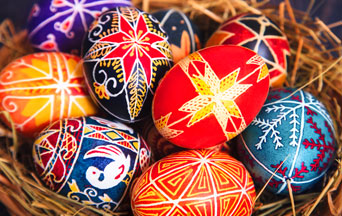
Although eggs are ordinary and simple, a Ukrainian art form transforms them from a mundane breakfast item to a sublime masterpiece worthy of kings.
This talent of etching or painting an egg is called pysanky. The art is full of symbolism related to Easter and many Catholic principles. Before the Ukrainians converted to Christianity, they followed the pagan custom of coloring eggs in the spring for use as lucky charms. In this way, they hoped to induce their false gods to provide for good harvests, health, weather and other benefits. When the first Ukrainians converted in the late tenth century, they saw they could Christianize this custom by transforming it into the famous pysanky. Thus, that crude talisman became an intricately beautiful symbol reminding the faithful of certain Catholic truths.
The Ukrainians soon embellished the eggs with new patterns and magnificent colors imbued with the Catholic spirit. The intricate beauty of a pysanka, writes one Ukrainian source, lies in the fact that “every element on this Ukrainian Easter egg is rich with symbolic meaning, including the individual colors: yellow stands for youth and purity; red represents the joy and passion in life; green is the color of spring, which brings hope and renewal; and black suggests the darkest time before dawn and the idea of eternity.” (https://svccoakville.com/ukrainian-easter-traditions-the-origin-of-pysanka/)
 Learn All About the Prophecies of Our Lady of Good Success About Our Times
Learn All About the Prophecies of Our Lady of Good Success About Our Times
The custom is intertwined with many traditions involving eggs. For example, according to Ukrainian Catholic tradition, Our Lady wept at the foot of the Cross, knowing well the sacred end of Redemption for which her Divine Son was suffering. Her mother’s heart could not help but try and alleviate His suffering. It is said that she had a basket of eggs with which she implored the soldiers to be less cruel. Thus, as she begged them earnestly, copious tears fell from her most blessed eyes, dotting the eggs with magnificent colors, making them shine brilliantly, and causing the nearby crowd to stare in wonder.
The story of Mary Magdalene involving eggs took place on her way to the sepulcher to anoint Our Lord. She carried in her basket the necessary oils ad balms for the anointing and eggs to be eaten afterward. When she arrived, the eggs, once snow white, were entirely resplendent in brilliant colors.
Traditions like these served as the fertile ground for pysanky to blossom and develop into a sublime art. Pysanka eggs came to represent Christian virtues and could even be customized to reflect the recipient’s personality, profession and traits. A carpenter, for example, might find his tools painted on his egg while the parish priest would see his church. The artists would employ a variety of materials, including paints, gems and precious metals. They would emboss the eggs with acids resembling wax, which leaves the shell etched with a pattern when removed. Thus, the Ukrainian pysanka shines with transcendent excellence, which causes souls to be overawed by their magnificence.
The pysanka takes something natural and raises it to the supernatural realm. That is why people around the world give these eggs as gifts for family and friends on Easter. The pysanka is resplendent with beauty and symbolism. It is a fitting symbol to lift hearts and minds to God on this most special feast celebrating the Redemption.
Photo Credit: © murika – stock.adobe.com

